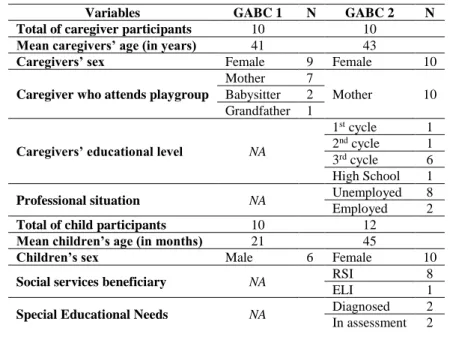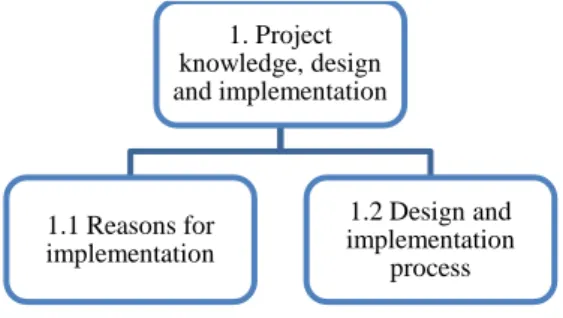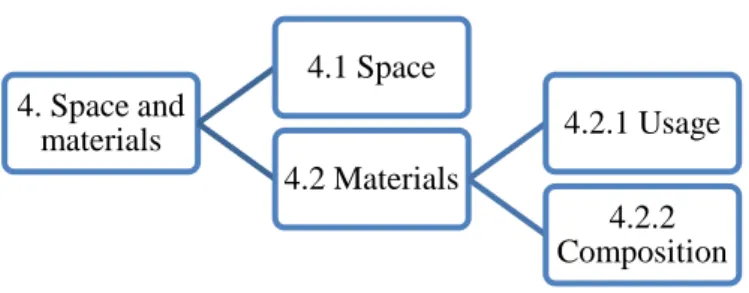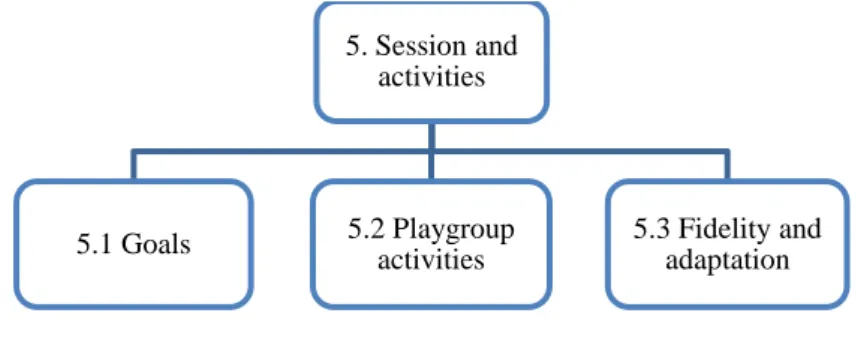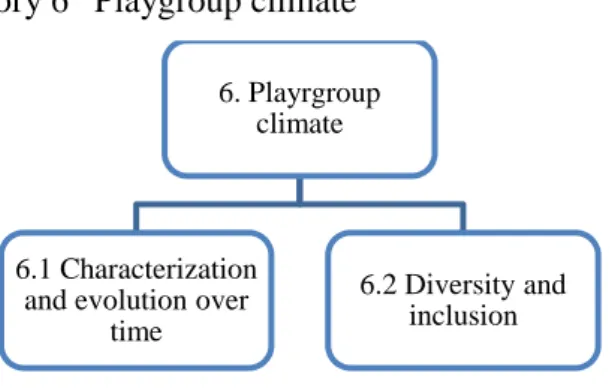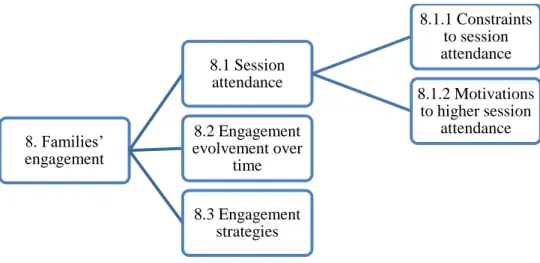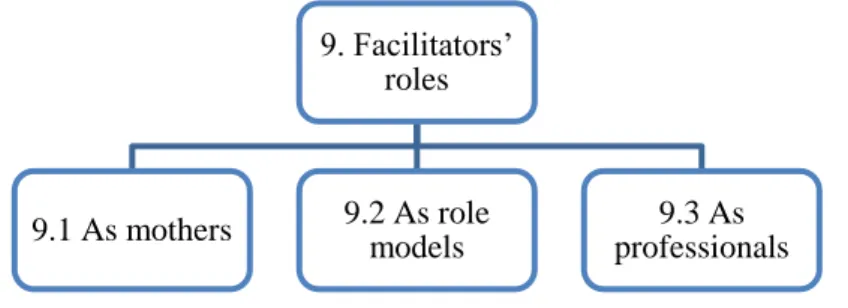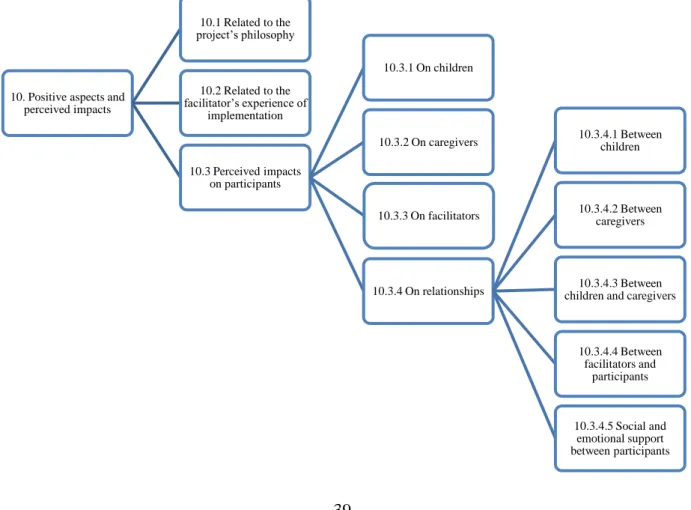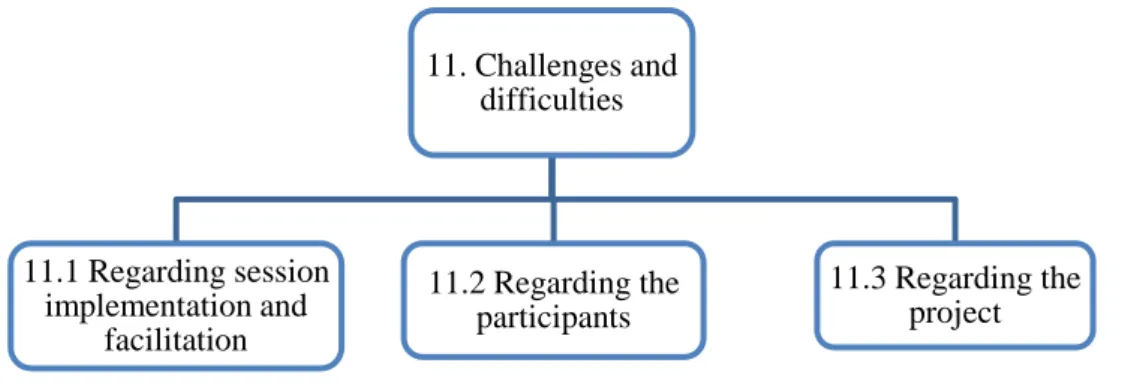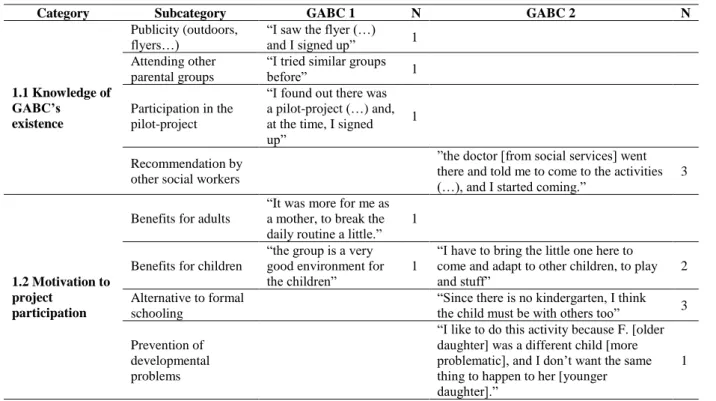IUL School of Social Sciences
Department of Social and Organizational Psychology
The aftermath of the pilot-project: A comprehensive analysis of the implementation of the new Playgroups for Inclusion/“Grupos Aprender, Brincar, Crescer”
Dissertation submitted as partial requirement for the conferral of Master in Community Psychology and Protection of Children and Youth at Risk
by
Catarina Alexandra da Cruz de Castro
Supervisor:
Joana Dias Alexandre, PhD, Assistant Professor ISCTE – University Institute of Lisbon
III
Abstract
Playgroups are a non-formal educational response for children under pre-school age and their caregivers to attend together, play and socialize. The playgroup model has been present in several countries, recently taking its first steps in Portugal with the pilot-project Playgroups for Inclusion (or “Grupos Aprender, Brincar, Crescer”, GABC). After its encouraging results, the goal has been to disseminate this service.
This dissertation aimed at a comprehensive analysis of these new playgroups, focusing on its quality, similarly to the monitoring process carried out during the pilot. Two GABCs were invited to take part in this comprehensive analysis. Interviews with playgroup facilitators (N=4) and with participating caregivers (N=10) provided an insight on their expectations, experiences and perceptions of playgroup implementation and participation. Complementarily, GABC sessions were videotaped in order to assess its process quality with an observational tool – the Playgroups Environment Rating Scale (PERS; Alexandre et al., 2016), developed by the pilot-project monitoring team for the purpose of evaluating quality in a non-formal educational setting with such particular characteristics as the playgroups.
Overall results showed a positive perception about playgroups by all parts involved, with caregivers describing improvements in their well-being, higher levels of social support and connectedness to others and the development of several skills in their children. Facilitators report a deep commitment to participant families, having their needs and preferences as a priority. Quality assessment with PERS revealed an above average overall process quality, in corroboration to the information gathered from the interviews.
This dissertation mirrors the family- and child-centered nature of this project, where the primary concerns are play activities and socialization. These results add to the body of evidence supporting the potential of playgroups as a non-formal educational response for the yearly years.
Keywords: playgroups, early education, quality, monitoring.
PsycInfo Scientific domains: 2956 Childrearing & Child Care; 3373 Community & Social Services.
IV
Resumo
Os playgroups são uma resposta educativa não-formal para a primeira infância, para crianças e os seus cuidadores frequentarem em conjunto com o propósito de atividades de socialização e brincadeira. O modelo dos playgroups tem vindo a estar presente em diversos países, dando os seus primeiros passos recentemente em Portugal com o projeto-piloto Playgroups for Inclusion (ou “Grupos Aprender, Brincar, Crescer”, GABC). Depois dos promissores resultados, o objetivo é o de disseminar este serviço.
A presente dissertação pretendeu conduzir uma análise compreensiva da implementação destes novos playgroups, com especial foco na sua qualidade, à semelhança do processo de monitorização conduzido no piloto. Dois GABCs foram convidados a participar nesta análise compreensiva. Entrevistas com as monitoras (N=4) e com cuidadores participantes (N=10) proporcionaram a compreensão das suas expectativas, experiências e perceções relativas à implementação e participação num playgroup. Adicionalmente, sessões de cada GABC foram filmadas de forma a permitir a avaliação da sua qualidade de processo com uma ferramenta de observação – a Playgroups Environment Rating Scale (PERS, Alexandre et al., 2016).
Os resultados desta recolha de dados refletem uma perceção positiva acerca dos playgroups por todas as partes envolvidas, com os cuidadores descrevendo melhorias no seu bem-estar, maiores níveis de suporte social e relação com outros, e o desenvolvimento de competências várias nas suas crianças. As monitoras relataram um elevado nível de compromisso para com as famílias participantes, tendo as suas necessidades e preferências como uma prioridade. A avaliação da qualidade processual com a PERS demonstrou uma qualidade de processo geral acima da média, corroborando a informação recolhida nas entrevistas.
Esta dissertação espelha a natureza centrada na família e na criança deste projeto, onde as principais preocupações são as atividades de brincadeira e socialização. Estes resultados contribuem para o corpo de literatura que apoia o potencial dos playgroups enquanto respostas educativas não-formais para a primeira infância.
Palavras-chave: playgroups, educação, qualidade, monitorização.
Classificação: 2956 Educação infantil & Cuidados infantis; 3373 Comunidade & Serviços Sociais
V
Table of Contents
Introduction ……….. 1
Chapter I – Theoretical Framework Why non-formal educational social responses matter ……….. 5
Quality in Early Childhood Education and Care (ECEC) ……… 6
Quality in non-formal educational settings ……….. 8
Playgroups: an alternative educational social provision ……….. 9
Benefits of playgroup attendance ……… 12
Playgroups for Inclusion or “Grupos Aprender, Brincar, Crescer”: a pilot-project in Portugal ……….. 16
Importance of monitoring implementation ………. 19
Objectives ……… 20
Chapter II – Method Sample ………. 21
Instruments ……….. 23
Data collection procedures ……….. 24
Data analysis procedures ………. 25
Chapter III – Results Interviews With facilitators ………... 27
With caregivers ……… 45
Playgroups Environment Rating Scale (PERS) ……….. 54
Chapter IV – Discussion ………. 57 Conclusions ………. 67 References ………... 69 Appendices Appendix A ………. 77 Appendix B ………. 81 Appendix C ………. 83 Appendix D ……….… 84
VI
List of Tables
Table 2.1 – Sociodemographic data on participants from both GABC ……….. 23
Table 3.1 – Content analysis’s Dimension 1 “Project participation” ……….. 45
Table 3.2 – Content analysis’s Dimension 2 “Overall assessment and perceived impacts” ……….. 46
Table 3.3 – Content analysis’s Dimension 3 “Space and materials” ……….. 49
Table 3.4 – Content analysis’s Dimension 4 “Activities and routines” ……….. 50
Table 3.5 – Content analysis’s Dimension 5 “Group climate” ………... 51
Table 3.6 – Content analysis’s Dimension 6 “Relationship with facilitators and evaluation of their work” ……… 52
Table 3.7 – Content analysis’s Dimension 7 “Participants’ engagement” ………….. 53
Table 3.8 – Content analysis’s Dimension 8 “Suggestions and future recommendations”... 54
VII
List of Figures
Figure 3.1 – Thematic analysis’s Category 1 “Project knowledge, design and
implementation” ……….. 27
Figure 3.2 – Thematic analysis’s Category 2 “Specific GABC training” …………... 28
Figure 3.3 – Thematic analysis’s Category 3 “Initial expectations” ………... 29
Figure 3.4 – Thematic analysis’s Category 4 “Space and materials” ………. 30
Figure 3.5 – Thematic analysis’s Category 5 “Session and activities” ………... 31
Figure 3.6 – Thematic analysis’s Category 6“Group climate” ………... 34
Figure 3.7 – Thematic analysis’s Category 7 “Community engagement” ………….. 35
Figure 3.8 – Thematic analysis’s Category 8 “Families’ engagement” ……….. 36
Figure 3.9 – Thematic analysis’s Category 9 “Facilitators’ roles” ………. 38
Figure 3.10 – Thematic analysis’s Category 10 “Positive aspects and perceived impacts” ……….. 39
Figure 3.11 – Thematic analysis’s Category 11 “Challenges and difficulties” …….. 43
Figure 3.12 – Thematic analysis’s Category 12 “Future recommendations” ………. 44
The first years of a child’s life are proven to be the cornerstone of their global development, not only when it comes to motricity, speech acquisition and behavioral skills, but also regarding their emotional and social development and adjustment in the most varied contexts (McCain, Mustard, & Shanker, 2007). Children’s well-being relies on strong and healthy attachment relationships and age-appropriate stimulation, which in turn are prompt to occur in the context of complex and dynamic social interactions between the child and his/her significant others (Oke, Stanley, & Theobald, 2007) and at their closest, most familiar and safe environments. It is, thus, consensual in the literature the utmost importance of providing a safe, stimulating, positive and protecting environment, where healthy nurturing relationships thrive (Walker et al., 2011).
In their early years, children’s main developmental contexts are their family and, should they attend one, an early childhood education and care (ECEC) facility. This makes primary caregivers, as well as teachers and peers, the source of a child’s most significant and predominant interactions. It is within these meaningful and positive interactions that most developmental milestones and skills acquisitions occur, thus highlighting its importance for children’s learning and development.
However, this safe and nurturing environment is not available in every household and may be of particular importance for children whose families face several risk factors (Duncan, Yeung, Brooks-Gunn, & Smith, 1998). In 2011, 28,6% of Portuguese children were at risk of poverty or social exclusion and in 2010 child material deprivation rates were of 27,5% in Portugal (Comité Português para a UNICEF, 2013). Due to an unstable economic and/or professional situation (with the latter being the most likely variable to affect risk of poverty), the lack of economic and material resources, or a situation of social exclusion, a portion of parents of infants and toddlers cannot provide them the previously described environment (Comité Português para a UNICEF, 2013) – whether it is at home or in enrolling their children in a center- or family-based ECEC setting –, thus missing the opportunity for their children to develop to their fullest. Missing this window may result in poorer performances in the child’s later life, whether it is regarding school achievement, social adaptation and behavior with peers and significant others, or emotional regulation and adjustment (Duncan et al., 1998).
In the past few decades in western societies there has been a tendency for parents to focus more on their professional development, with women’s labor market participation
2
growing exponentially; the Portuguese example is one of the most prominent in Europe, with over 60% of children living with both working parents and with 76% of mothers of children under three years old working (Barros et al., 2016). This results in a growing need for education and care alternatives for infants and toddlers, and governments have become aware of the necessity to extend ECEC coverage for children before compulsory school-age (e.g., Leseman & Slot, 2014; Myers, 2004; OECD, 2018). On the other hand, this expansion in terms of coverage is seen as a way of ensuring equity for all children, leveling their chances and opportunities for appropriate education and development. Those efforts have been sought out all across Europe in the latest years, and coverage rates in Portugal have grown from 12,65% in 1996 to 42,6% in 2013 for children under the age of three (Barros et al., 2016; Barros & Aguiar, 2010); the recent establishment by the Portuguese government of universal access to preschool for all 4- and 5-year-olds resulted in current attendance rates of 93% for 4-year-olds and 98% for 5-year-olds (Cadima, Aguiar, & Barata, 2018). Research shows that attending an ECEC setting may support cognitive and language development (Burchinal et al., 2000), especially in high quality settings1 (Gormley, Gayer, Phillips, & Dawson, 2005); attendance of pre-primary education also seems to improve school readiness (Wong, Cook, Barnett, & Jung, 2008) and long-term school achievement (OECD, 2014). However, despite efforts on expanding coverage of ECEC services, early childhood education is still not considered part of the formal Portuguese educational system, with only the two years immediately preceding primary schooling being worthy of main investment, which leaves a whole in the provision of high quality and quantity of educational responses for the first years of children’s lives (Taguma, Litjens, & Makowiecki, 2012).
This rise on the coverage of ECEC settings does not mean however that they are of universal or public access. In Portugal, enrolment rates are estimated to be 25% to 30% lower among children from disadvantaged backgrounds, when compared to those from advantaged families (OECD, 2014). This lack of quality education and care options, especially for those who have difficulty accessing the formal system, is of the utmost concern in the described portion of the population where children live in risk of poverty or without the necessary material, economic or affective resources needed to promote their fully healthy development (Walker et al., 2011).
1 Educational quality can be understood in terms of structural features (with aspects such as group size, child-teacher ratio, or teacher training) and process quality (regarding daily routines and interactions between children and adults). The concept of educational quality will be addressed in detail further down this dissertation.
3
Non-formal educational programs have been emerging as a response to the formal ECEC service gap, especially for disadvantaged families. One model of alternative early education service that has been being established in several countries for the past few decades is playgroups: local group gatherings for young children and their caregivers to come together for the purpose of play and social activities, promoting the development and learning of both child and adult (Dadich & Spooner, 2008). As will be further explored, similarly to formal educational services, these sorts of community provisions must also ensure they deliver a high quality service for children and caregivers (Ramsden, 1997); this is an aspect not thoroughly explored in the literature, despite the long history of implementation of these educational programs. A pilot-project conducted in Portugal, entitled Playgroups for Inclusion (or Grupos Aprender, Brincar, Crescer) aimed at implementing the playgroup model throughout the country while monitoring its quality and evaluating its impacts, and obtaining interesting results on both areas of research, as will further be addressed. This dissertation aimed at locating two playgroups being currently implemented in the greater Lisbon area, and inviting them take part in a comprehensive analysis that would rely on their own perceptions and experiences as playgroup participants, as well as on the careful observation of playgroup sessions, focusing on its activities and routines, the group climate and the interactions between children and adults, i.e., the overall playgroup process quality, following what has been done in the pilot-project.
This dissertation follows a structure of four chapters. Chapter I concerns the theoretical framing on early years education and on social non-formal educational settings, with particular focus on the playgroup methodology and on its history of implementation in Portugal; Chapter II addresses methods, including sample, instruments, and data collection and data analysis procedures; Chapter III presents the results from interviews with facilitators and caregivers, as well as from the quality assessment with a quality observation tool (PERS); finally, Chapter IV concerns the discussion, future recommendations for research and practice, and limitations to this dissertation.
5
Chapter I – Theoretical Framework
Why non-formal educational social responses matter
Considering the concerns described in the Introduction section, the question seems to be, thus, what alternatives could be available in order to fulfill the gap on the coverage of ECEC provision? Could different early childhood education programs complement other contexts of child development, such as family and community – in a systemic perspective – in order to positively impact child learning and development? And if so, would the quality of these provisions matter (Myers, 2004)?
Research seems to answer affirmatively, with benefits not only for children but also for families and communities. Studies also reinforce the belief that the effects of a high-quality educational program on young children’s development seems to be larger for children from disadvantaged backgrounds, suggesting that quality in ECEC may act as a buffer to risk factors possibly present in other contexts (Burchinal et al., 2000; Myers, 2004). ECEC has been shown to be one of the most cost-effective strategies to fight the negative effects of poverty on child development, as well as one of the strongest weapons to break the cycle of poverty (Leseman & Slot, 2014).
The literature also points out to the fact that programs which combine education and care for infants and toddlers with parental education seem to have a larger positive impact than those focused solely on children or on parents (Myers, 2004). This comes as a reminder of the importance of supporting families as a complement of providing ECEC access to their children, especially in situations of risk and/or disadvantage. The accumulation of risk factors (such as poverty, social exclusion, low education levels, or exposure to violence) may be lessened by a strong social support network, which can and should be provided through several community services (Leseman & Slot, 2014). Supporting parents seems to be one of the most effective ways of improving overall child well-being (Rochford, Doherty, & Owens, 2014), especially through improvements on the quality and quantity of dyadic interactions (Deutscher, Fewell, & Gross, 2006). Also importantly, parental groups seem to promote social cohesion and support networks that reduce parental stress and feelings of loneliness, hence contributing to a better family environment and to the strengthening of the community, able to be sustained in a longer term (Hanna, Edgecombe, Jackson, & Newman, 2002). Prevention and early intervention programs that focus on the first years of a child’s life, support their learning and development, while also supporting parents, and engage the community and make use of its resources seem to be a well conceived formula for the
6
protection of families and the promotion of their positive development (Rochford et al., 2014).
Although they are the ones who benefit the most from the experience of joining any type of community service, either for them or their children, disadvantaged families are also usually the ones who are less likely to seek and/or enroll in this type of service (Barlow, Kirkpatrick, Stewart-Brown, & Davis, 2005; Cortis, Katz, & Patulny, n.d.). Not only do children from vulnerable families attend less educational and developmental programs (Hancock et al., 2012), but also these parents participate far less in any sort of local initiatives or programs, avoiding contact with services in general (McLean et al., 2017). These are the so called hard to reach or out of reach families: those who, in light of their disadvantaged life circumstances, accumulation of risk factors, situation of social exclusion or lack of several resources face greater difficulties in knowing and engaging in several community services and initiatives, making them a priority target for parent and child educational programs (Barlow et al., 2005). Considering the findings that claim these vulnerable families are the ones who benefit the most and on who the impact of educational programs is more significant, it must be ensured that programs succeed in attracting, enrolling and engaging both parents and children, while also bearing in mind the utmost importance of delivering a quality service, with positive interactions between children, caregivers and technicians, with adequate educational content and an overall positive climate. One way to ensure a high quality standard is to monitor the quality of the early education service in which families take part.
Quality in Early Childhood Education and Care (ECEC)
There is some international consensus on what is considered to be necessary to promote young children’s adequate development, as well as on what outcomes societies seek to achieve on children and what are the educational means to achieve them (Tietze, Cryer, Bairrão, Palacios, & Wetzel, 1996). The characteristics of early childhood education and care facilities that affect children’s development are what constitute its quality. Quality in ECEC is most commonly defined in terms of its structural and process characteristics, which are thought to influence child development and learning (NICHD, 2002). This “structure and process” view helps policy makers define quality standards that may guide educational practices at a broader, more standardized level; however, despite these central and common dimensions of quality that research and policy attempt to establish, and that allow some level of agreement on how to define and assess quality, it must be taken into account a certain degree of variation and diversity among different social, economic and cultural contexts
7
(Myers, 2004). Some tools have been developed for quality assessment in formal early childhood education and care settings, such as ECERS (Early Childhood Environment Rating Scale; Harms & Clifford, 1980), ECERS-R (Early Childhood Environment Rating Scale – Revised; Harms, Clifford & Cryer, 1998) or ITERS-R (Infant/Toddler Environment Rating Scale; Harms, Cryer & Clifford, 2006), as well as the CLASS (Pianta, La Paro, & Hamre, 2008) or the Leavers’ scales of involvement (Leavers, 1993, 1994).
Structural indicators are the more distal, quantitative and easily measurable characteristics of ECEC, and thus more regulable; it includes aspects such as group size, child-adult ratio, teacher’s education or physical characteristics of the setting. More importantly, these indicators are thought to be pre-conditions for process quality, working as frameworks for the interactions and activities children experience in their daily routines (Barros et al., 2016; Slot, Leseman, Verhagen, & Mulder, 2015; Taguma et al., 2012). Structural aspects are also the most common indicators used to inform policy makers and to fix quality standards at a larger scale (OECD, n.d.).
On the other hand, process indicators refer to children’s daily direct experiences, such as the frequency and type of interactions with caregivers and peers, the type of activities they carry, or the materials with which they interact (Barros et al., 2016). They are the overall way of interacting with and approaching children, and of providing them with activities that promote skill acquisitions and learning; high process quality should include characteristics such as adult-child affectionate and responsive interactions, with high levels of guidance and verbal stimulation, and affectionate overall group climate, with positive social interactions between children and where opportunities to learn and develop thrive (Leseman & Slot, 2014). Process aspects are seen as proximal determinants of child development (Slot et al., 2015) and are of particular importance for quality in ECEC (Litjens, 2014), since research points out to process quality, particularly caregiver-child interactions, as privileged means for child development and learning (Barros et al., 2016).
Of great interest in the literature has been the relationship between structural indicators, process indicators and child outcomes. Since structure is seen as a more distal aspect of child development, and process a more proximal one, several studies have been highlighting the mediation path through which structural characteristics influence child development (especially social and cognitive skills), i.e., through process aspects (NICHD, 2002). Even though current available findings are still moderate and mixed, studies seem to present some evidence that supports this mediation path, where the strong direct effect of process quality on child development and skills is preceded by a (less strong) indirect effect
8
of structural quality on child outcomes, through process indicators (NICHD, 2002; Slot et al., 2015; Slot, Bleses, Justice, Markussen-Brown, & Højen, 2018).
Quality in non-formal educational settings
Similarly to formal educational settings, non-formal educational responses must also guarantee they deliver a quality service, serving children and families with high-quality content within positive interactions that stimulate children and provide a safe, nurturing environment for both them and their caregivers (French, 2005). These previously described programs must act not only as educational settings but mostly take advantage of their privileged closeness to families and communities, working alongside them, strengthening them and promoting the acquisition of parental, social and personal skills, as well as the development of social networks and social support in their communities. One way to help the achievement of these ambitious goals, and similarly to a context of formal education, is to guarantee the programs are delivered with the highest possible quality, within positive interactions and adequate resources (Nyland, Nyland, Gao, Ng, & Zeng, 2016).
In an attempt to answer to these concerns, one type of social and educational response started to gain popularity amongst several countries in the past few decades: a group gathering, where caregivers would come with their young children and spend some time socializing with other adults with infants, while engaging in activities that stimulated their learning and socialization. These are the so called playgroups: a local, community-based group that brings together preschool-aged children and their parents or carers for the purpose of play and social activities (Dadich & Spooner, 2008). Playgroups as a model of early intervention in education have been well established in terms of its implementation, but studied to a lesser extent when it comes to why the program seems to work and under what concrete circumstances (Jackson, 2011, 2013). In other words, few playgroups been examined in terms of their quality (Barata, Alexandre, de Sousa, Leitão, & Russo, 2016; Ramsden, 1997) due, in part, to an absence of the appropriate methods for quality assessment in a non-formal ECEC provision with such particular characteristics as the playgroups. Some examples of research (e.g.: French, 2005; Johnston & Sullivan, 2004) attempted to scratch the surface on educational quality in playgroup settings, relying mostly on stakeholders’ feedback or, when resorting to observation tools, applying those designed for formal early childhood education and care settings (Cunningham, Walsh, Dunn, Mitchell, & MCalister, 2004).
Considering that quality matters also for non-formal educational programs, as well as the relevance of fulfilling this research gap, a pilot-project conducted in Portugal between
9
2015 and 2017 (Barata et al., 2016) aimed at designing, implementing and evaluating several playgroups throughout the country, studying not only their impact on participating families but also monitoring their quality based on feedback from the participants and on the observation of playgroup sessions. The research team developed a quality observation tool – the Playgroup Environment Rating Scale (PERS; Alexandre et al., 2016) – specifically for playgroup contexts, that allowed to assess process quality in terms of space and materials, activities and routines, diversity, group climate and interactions between participants. Although still currently under study, the observational tool developed during this pilot investigation aims at serving the purpose of fulfilling a gap in the literature regarding the evaluation of quality in non-formal educational provisions for the early years, in particular for this playgroup working model, proving to be an ambitious pioneer research project in this area.
The present work will now attempt to further detail what is this playgroup model of early education and to what extent it impacts children, caregivers and local communities, as well as what constituted the pilot-project carried out in Portugal previously briefly described.
Playgroups: an alternative educational social provision What are playgroups?
To more explicitly define the playgroup working model, the Australian Commonwealth Government describes playgroups as “regular, informal gatherings for parents and caregivers of children under school age” that “provide opportunities for children’s social, emotional, physical and intellectual development while also providing opportunities for parents and caregivers to establish social and support networks to encourage and assist them in their valuable parenting role” (Department of Family and Community Services and Indigenous Affairs, 2006, cited in Dadich & Spooner, 2008; p. 95). These gatherings happen on a weekly basis, in local community settings (like libraries, schools, or other public venues), with the aim of promoting the child’s healthy development and learning, through socialization and educational play activities, while also providing the caregivers the opportunity for parental and personal skills acquisition; also, playgroups have the ability to connect the parents or caregivers with each other in a way that promotes the development of safe and strong social networks, hence strengthening the local community.
The playgroup movement is the result of an increasing awareness on the value of play in children’s development (Gregory, Harman-Smith, Sincovich, Wilson, & Brinkman, 2016; Whyte, Daly, Bujia, & Smyth, n.d.), and it has been growing from being perceived as a tool to
10
fill in a service gap (i.e., the shortage in pre-school services) to the understanding of playgroups’ potential to enhance social capital, strengthen communities, and educate parents to better support their child’s development, in particular through the facilitation of play (McLean et al., 2017). Play activities have proven to be a key mechanism through which children interact with and learn about the world around them, contributing to their “growth, development, socialization, communication and creativity” (Fabrizi, Ito, & Winston, 2016; p. 1), and it is fundamental for children’s development, as recognized by the United Nations Convention for the Rights of the Child(1989); play is also associated with the development of language and literacy, sociability and mathematical ability (Santer & Griffiths, 2007). In their review on supported playgroups, Commerford and Robinson (2016) sum up the theoretical underpinnings to this educational model: aside from (1) the importance of play in child development, as mentioned, playgroups are also based on (2) an ecological approach of human development, with different systems of the child and family’s lives interacting directly with the individual as well as between them, influencing their growth; and also on the concept of (3) the group as a source of social support, through the connection of different caregivers who may share the same similar life moments, ultimately influencing young children’s well-being and development (Commerford & Robinson, 2016).
Thus, guided by a child-centered approach, playgroups provide stimulating and challenging opportunities for children, while ensuring they feel “happy, relaxed and at home in the environment” (Whyte et al., n.d.; p. 8), with the ultimate goal of providing learning through play.
Even though literature often depicts playgroups as generally being broken down into two main types of arrangement, it should be taken into consideration that this strict distinction serves mainly for the purpose of clarity, and that each existing model of playgroup arrangement can be placed along a continuum of interventive facilitation, with each model having its own way of operating, its own goals and outcomes, which may be more or less similar between each other (Dadich & Spooner, 2008). With that said, there can be found mainly two types of playgroups: those that are self-managed (also called community playgroups) and those that are supported, i.e., that are lead by a facilitator that is usually a trained early childhood educator (known as facilitated or supported playgroups; Commerford & Robinson, 2016). In some countries like Australia or Ireland, where playgroups have played an important role as a response in the early childhood landscape for decades, they may be inserted in a nation- or state-wide playgroups network, benefiting from the occasional supervision and advice of higher, more specialized instances (Commerford & Robinson,
11
2016; Gregory et al., 2016). In their work on the origins and rationale of different types of centers for parents and young children together in different countries, Hoshi-Watanabe, Musatti, Rayna, and Vandenbroeck (2015) reflect on how this educational model gained recent popularity and spread out around the world (namely in Belgium, Italy, France and Japan), despite having more or less similar theoretical and methodological approaches. Although not under the “playgroup” designation, these mostly European models of educational centers for dyads to attend together aim at supporting families and answer to insufficient child-care provision, and to needs of socialization, parental support and community connectedness (Hoshi-Watanabe et al., 2015).
For the purpose of this dissertation emphasis will be given to supported playgroups, as this is the model closer to what has been done so far in Portugal. It’s important to note, however, that some other similar initiatives have been taking place sporadically across the country for the past few years2 and, although not sharing the playgroup name, they share some aspects related to their purposes and methodologies. The playgroups presently under study and that constitute the sample of this investigation, as well as the ones implemented and studied extensively during the pilot-project, are inspired by both the European model of playgroups (such as the ones in Italy or Belgium, previously described) and the Anglo-Saxon model (as in Australia or Ireland), as will further be detailed.
Thus, supported (or facilitated) playgroups are initiated by a third party (frequently a governmental or not-for-profit organization) and conducted, managed and facilitated by a paid facilitator, usually and preferably with expertise in early childhood education and care. Supported playgroups “have a dual focus on supporting the development and wellbeing of both children and their parents, together” and “aim to support families and children with particular needs and vulnerabilities” (Commerford & Robinson, 2016 p. 42). Supported playgroups can therefore be directed towards families in socioeconomic disadvantage, families with children with special needs or some type of physical or cognitive impairment (Chen, Hanline, & Friedman, 1989), immigrant families from culturally diverse backgrounds that may experience some type of social exclusion (Warr, Mann, Forbes, & Turner, 2013), communities of migrant families, such as in China (Nyland et al., 2016) or families of young parents. Regardless of aiming at any specific group, supported playgroups are always
2 https://a-par.org
12
welcoming to all types of families, ensuring a safe, positive, nurturing environment for both children and their caregivers.
The playgroup model seems, thus, to be a social response that contributes for the general well-being of both individuals and the community, providing a complex and yet sustainable service for the positive development of all participants. The particular benefits associated with its different levels of intervention are now further explained.
Benefits of playgroup attendance
Despite their child-centered nature, playgroups are tools that produce positive change not only to the child but also at the family and community levels (Oke et al., 2007). There are few studies aiming at understanding how effective playgroups are at achieving their goals. However, the limited evidence base currently at disposal seems to shed light on positive changes for all participants, adding up to the body of literature that advocates for the benefits of playgroup participation for all (Hancock, Cunningham, Lawrence, Zarb, & Zubrick, 2015).
Benefits for children
Besides providing fun and enjoyment, play activities are proven to be linked to language and literacy development, while also encouraging learning and exploration on infants and toddlers, pushing them to interact not only with the material environment but also with others, whether it is peers or other adults. This establishment of early relationships helps children understand how others think, feel and behave, as well as how they should emotionally respond to social situations. It helps building social and personal skills, like self-confidence, alongside emotional regulation and cognitive development (Oke et al., 2007).
One research project by Cunningham, Walsh, Dunn, Mitchell and MCalister (2004) attempted to assess three and four year old children’s perceptions about the playgroups they attended, demonstrating young children can also provide valuable insight on their experiences if given a voice to do so. However, most of the literature on the effects of playgroup participation on children relies upon caregiver’s reports of changes they perceived in their child thanks to their playgroup enrolment. For instance, Oke, Stanley & Theobald (2007) interviewed a sample of Australian caregivers from several different cultural backgrounds who said their children “enjoyed attending and benefited from the opportunities for socialization and interaction with other children”, which could be seen from an improvement on children’s sharing capacity and routine familiarization (Oke et al., 2007; p. 13). This
13
relational improvement on children, reported by their caregivers, was also found by Commerford & Robinson's (2016) literature review, where a number of studies highlights positive changes on social skills such as getting along with other children and learning to share. Parents also seem to share the belief that playgroups are a privileged source of new learning opportunities, with their children becoming more confident and more engaged in play over time (ARTD Consultants, 2008); speech development (ARTD Consultants, 2008; DEECD, 2012) and the learning of new behaviors (ARTD Consultants, 2008) are also pointed out as notable improvements. These enhanced social skills are also reflected on child-parent interactions, as noted by Vandell (1979), since toddlers who participated in playgroups became more responsive to their parents and engaged in more reciprocal interactions, when compared to toddlers under homecare, suggesting a facilitative effect of playgroup experience on their social skills (Vandell, 1979).
Playgroup participation is also associated with children’s school readiness, since they provide a first contact with educational routines, with other children and with other adults of reference, as well as cognitive and linguistic development. Thus, toddlers who attend playgroups experience a smoother transition to school environment, reducing the stress and anxiety associated with the beginning of this new life cycle (Knaus & Warren, 2015; Mclean & Schaper, 2011).
An important study by Hancock et al. (2012) with a sample of Australian children provides key evidence that continued playgroup participation is associated with significantly improved child outcomes at age 4-5 on learning competence and social and emotional functioning, and that this impact is of greater significance for children from disadvantaged families. This may be so, according to the authors, due to the lack of resources that children from lower socioeconomic status have at their disposal on a daily basis at home, which means they would be the ones who would benefit the most from attending playgroups (Hancock et al., 2012). If so, this would mean that the improvement on developmental outcomes for children who attend playgroups on a continued basis (in comparison to those who do not) would be even more evident among children from lower socioeconomic status.
Johnston & Sullivan's (2004) evaluation of supported playgroups’ implementation and outcomes in an Australian community also found that the participation of at risk families in this service resulted in vulnerable children being less likely to be exposed to abuse and neglect, and in their life chances and environments improvement due to this early intervention strategy (Johnston & Sullivan, 2004). These findings highlight the importance of the benefits not only for children but also for their caregivers, since this improvement on the quality of the
14
home environment is a reflex of the process of parental education and support carried out during playgroup sessions.
Benefits for adults
As stated previously, it is more difficult to care for a child when the carer faces a condition of social exclusion and multiple risk factors; this means that improving such life conditions would be key to a healthier development for the child. Playgroups play a major role to the caregivers personally, as they have been found to improve significantly their well-being, psychological health and social and emotional support networks (Berthelsen, Williams, Abad, Vogel, & Nicholson, 2012), not only by providing them with the skills necessary to succeed in their parenting role but mainly by connecting them to other parents with whom they may empathize, share experiences and form strong bonds over time (e.g.: Hancock et al., 2015; Jackson, 2011).
Several studies on the impact of playgroups rely on participant caregivers’ reports of what they perceive as being the positive outcomes of their experience. Parents very often offer a description of their positive social experience, reporting the development of new relationships – even friendships – with other parents (Hancock et al., 2015) and of different types of support (Jackson, 2011), while also recognizing the importance of learning new information and skills on caring for their young children (Berthelsen et al., 2012). This acquisition of parenting skills brought them higher levels of confidence, seen through an increase on initiating and joining activities with their children, socializing with other parents (not only at the playgroup but also outside of it, showing the development of friendship bonds) and by applying at home what they learn in playgroup setting (AIFS, 2011).
On their report of playgroup functioning seen through the eyes of participating parents, Berthelsen et al. (2012) aimed at understanding what caregivers perceived as being the biggest benefits of their playgroup participation, for both them and their children, as well as what they thought were the main downsides and difficulties faced during this experience. Participants reported that playgroup participation helped them to understand child development, to learn new ways to play with and to teach their young children, to find out about other services available and, most of all, to meet and talk with other parents. The authors also report an increase on parental well-being, through a decrease of depression episodes and an improvement of overall health after participating in playgroups. More importantly perhaps, this report found that families who attend more regularly to playgroup sessions reported more benefits from this participation than those who attended less often,
15
while also displaying higher levels of engagement in the activities and higher levels of satisfaction (Berthelsen et al., 2012). Attendance and engagement in playgroup sessions are thus key elements for the achievement of positive outcomes for both parents and children (Jackson, 2013).
Playgroups are a privileged site for parental education, particularly through the enhancement of parents’ awareness of their young children’s learning and development through play (McLean et al., 2017). Learning about their toddler’s needs and understanding their development, while also realizing they have the tools necessary to succeed in this task, provides parents with a sense of empowerment, contributing to greater esteem and self-confidence, and overall well-being (Jackson, 2011). On the other hand, this opportunity to grow out of a possible social exclusion situation by facilitating caregiver’s community connectedness – to both people and services – contributes positively on an individual level (on the well-being of the adult), on a familiar level (by improving the quality of family relationships and providing them with a more solid social network) and at a community level (contributing to the increase of social capital on a stronger, healthier community; Oke et al., 2007).
Benefits for the community
Playgroups have also displayed – although to a lesser extent, as this is the least studied aspect of playgroup impact – to have effects on the community in which they take place. Caregivers who attend playgroups tend to develop an easier and more positive relationship with other formal and informal local services, while also taking more interest and engaging more in other community initiatives (Berthelsen et al., 2012; Jackson, 2011). Regarding migrant and socially and culturally excluded families, playgroups have also shown to have a “bridging role” in linking these families and local service systems, due to a work model that considers and respects their needs and concerns (Warr et al., 2013), while also promoting social inclusion by being affordable and of universal access, providing acceptance of diversity and equal opportunities for all children (Whyte et al., n.d.). The development of relationships between adults participating in a playgroup greatly contributes to the enhancement of social support and the development of social networks, which ultimately contribute to strengthen the local community and develop its social capital (Dadich & Spooner, 2008). Playgroups as a vehicle to enhance communities’ social capital is one of the most mentioned benefits of playgroup implementation at a local level (Gibson, Harman, & Guilfoyle, 2015; Mulcahy, Parry, & Glover, 2010), as well as the increased collaboration and networking between
16
different local early childhood services as a consequence of playgroup implementation on the community (AIFS, 2011).
It is important to keep in mind that, although these previously described benefits are relevant and encouraging on their own, they remain relevant only if aspects such as attendance, dosage or engagement are taken into consideration, i.e., if the families effectively attend the playgroup and engage in the activities within a quality setting (Zaslow et al., 2011). Matters of quality have been addressed previously, but particular aspects such as dosage (which concerns the amount or timing of participation in a given setting, such as ECEC or a playgroup; Zaslow et al., 2011) and engagement (the level of involvement in activities as well as the level of social participation of parents; Berthelsen et al., 2012) were also accounted for and reflected upon, not only in the pilot-project about to be described but also in the present dissertation, as will further be addressed.
Playgroups for Inclusion or “Grupos Aprender, Brincar, Crescer”: a pilot-project in Portugal3
In some countries like Australia, England or Ireland, playgroups are already seen as a well-established education and care option in itself, working for several decades now and relying on a strong national network for guidance, implementation and monitoring (Oke et al., 2007; Ramsden, 1997). Despite its long implementation history in other countries, the playgroup model is still not a common response for families in Portugal, although there can be found some examples of similar initiatives acknowledging the importance of such a provision (as previously stated).
The first movement took place between 2015 and 2017 with a pilot-project of national reach, carried out by a national consortium which included the Directorate General of Education (DGE), the Bissaya Barreto Foundation (FBB), the Calouste Gulbenkian Foundation (FCG), the High Commission for Migration (ACM), the University of Coimbra and ISCTE – University Institute of Lisbon, counting with the support of the European Union (EU). The project “Playgroups for Inclusion” – or in Portuguese “Grupos Aprender, Brincar, Crescer” (or GABC, which may translate to “Groups to Learn, Play and Grow”) – aimed at implementing playgroups in five districts in Portugal (namely Aveiro, Coimbra, Lisboa, Porto
3 For a detailed report on the pilot-project please see Barata, Alexandre, de Sousa, Leitão and Russo (2016).
17
and Setúbal) throughout a 10 month period, for children from birth to four years of age who did not attend any formal educational facility, together with their main caregivers.
The national consortium aimed at designing, implementing, evaluating and disseminating this innovative educational program for ECEC, pioneer on the early years education and care landscape. This was also the first international randomized controlled trial (RCT) of a playgroups-only program, with an experimental group of families and a control group; the control group benefited from a 3-month intervention in the later stage of the project. The experimental evaluation revealed promising results regarding children’s language and cognitive development, their social and behavioral skills, as well as caregivers’ goals, values and aspirations, and their personal well-being (Barata et al., 2016).
Besides the study of program impact, the consortium institutions also carried out a study of program implementation, with special focus on aspects related to its quality. The implementation study aimed to attribute with a higher level of certainty the observed outcomes in participants to aspects related to implementation variables, as well as to “have a broader comprehensive analysis” of the program implementation from different stakeholders’ perspectives (Barata et al., 2016, p. 127). The data collection procedures covered key areas to the implementation of community programs such as – but not only – matters of dosage, responsiveness or quality of implementation, with a diverse methodology that encompassed documentary analysis, focus groups, individual interviews, questionnaires, and session recordings. As described in the previous section, it was of particular importance to monitor and guarantee high levels of playgroup quality, participants’ attendance (related to dosage), as well as caregivers’ engagement in the playgroup; these features result on a proper program implementation and improve the chances of more significant impacts on the participating families (Barata et al., 2016; Zaslow et al., 2011).
As said, emphasis was given to matters of quality of the playgroups, regarding the following aspects: space and materials, activities and routines, contact with diversity, and climate and interactions. To better assess these relational and interactional aspects of quality, it was developed an observation tool – the Playgroup Environment Rating Scale (PERS). The PERS (Alexandre et al., 2016) is an observation tool developed during the GABC pilot-project by its monitoring team, and is born from the need for a specific instrument that would assess indicators of quality in a playgroup context – which is, in several aspects, fundamentally different from the process quality one would expect in a formal educational setting. As stated previously, in most environmental quality assessment studies conducted in playgroups researchers make use of observational tools such as the ECERS/ECERS–R
18
(Harms & Clifford, 1980; Harms, Clifford & Cryer, 1998) or the QLI (Quality Learning Instrument; Walsh, 2000), specific for formal center-based ECEC provisions. This gap is often pointed out in the literature, and motivated the monitoring research team from the pilot-project to develop this observational instrument (mostly inspired by the ITERS–R and on Leavers’ engagement and involvement scales), that conveys aspects such as interactions between participants, activities, routines and overall climate of the playgroup4. PERS was conceived to facilitate the observation of playgroup implementation and the understanding of what is a day in the experience of participating families at a playgroup. This scale is still, as previously mentioned, under study for validation; however, during the pilot-project it was subject to interrater agreement and the researcher who intends to apply this observation tool has to undertake a training process, as was the case for this dissertation and as will be further explained.
The results of the “Grupos Aprender, Brincar, Crescer” project regarding the studies of impact and implementation, made public in 2017, are encouraging and constitute an incentive to the dissemination of this model of educational response for the early years in Portugal. It is now up to the local communities to implement the GABC model and put it to its families’ service. The national consortium of the pilot-project still tries to monitor and assist the new playgroups that are arising at a local level, by supporting them and ensuring they remain truthful to the theoretical principles that guided the playgroup philosophy defended during the pilot-project.
Several community institutions embraced this challenge and were able to implement their own GABC in different local communities. The present dissertation aimed at locating (in the greater Lisbon area) those working playgroups – that were directly inspired by the pilot-project and that thus followed its foundational principles – and inviting them to take part in a quality monitoring process, with caregivers and facilitators as primary sources of information. This search resulted in the contact with two playgroups (also referred to as GABC) that had been running for several months, thus showing a solid – although brief – implementation history in their communities. It must be taken into consideration however that, despite being inspired by the pilot-project, these playgroups currently being implemented have been adjusted to local families and their specific needs, which makes them differ from the ones from the pilot-project in some characteristics; for instance, they allow several children from
19
one same caregiver to attend, while also not imposing an age limit or the condition of not attending any formal educational setting. This results in adult participants frequently attending with more than one child, often over pre-primary school age and that may be enrolled in other educational services. Because they are not an organized network managed by the same stakeholders, the present GABCs reached by this study do not also benefit from the oversight of a supervisor or the guidance of a structured large-scale provision that ensures standardized policies and practices for the different local GABCs.
Due to the promising results obtained from the Playgroups for Inclusion pilot-project, and because playgroups play such a large role in the early years’ landscape in several countries, it becomes necessary to carry this comprehensive analysis on their current implementation in order to pave the way for a deeper level of understanding on playgroup functioning in the Portuguese scenery, as well as to document the sustainability of the project itself.
Importance of monitoring implementation
For all of the expressed above, these playgroups currently taking their first steps are worthy of a closer look to their implementation and to what several stakeholders experience from them. Such is possible through a monitoring process that keeps up with the different steps of program implementation and considers several viewpoints when it comes to how this program works, why and for whom.
Monitoring program implementation is one key path to ensure program goals are met, and that eventual resulting impacts are in fact due to an adequate and effective program delivery and implementation (Durlak & DuPre, 2008). This monitoring process becomes more necessary when programs are disseminated and replicated in the communities (i.e., “in the real world”), since the maintenance of a high quality level is one of the main challenges to program effectiveness (Dusenbury, Brannigan, Hansen, Walsh, & Falco, 2005). There are inherent aspects to implementation which must be followed to ensure program efficacy, including (but not only) fidelity, adaptation, dosage and quality (Durlak & DuPre, 2008); these aspects were thoroughly monitored during the pilot-project implementation, and shall also be addressed in this dissertation, although not with the same level of detail (as will further be explained), hence this dissertation constituting a comprehensive analysis of playgroup implementation rather than an exhaustive monitoring process. Monitoring processes usually imply returning the assessment to the several program stakeholders, in order to promote improvements and adaptations, which was not the case for this dissertation; thus, it
20
lacks this participatory component which would allow for eventual changes and alterations to program delivery, making this a comprehensive analysis more than a true monitoring process. This comprehensive analysis is thus pertinent to better ensure these playgroups were delivered with high levels of quality, while also allowing for a deep understanding of the experience of facilitators and caregivers regarding this particular project; their insights may be valuable to the comprehension of how and why playgroups seem to work for parents, children and communities.
Objectives
Considering the exposed so far, this dissertation aimed at locating two playgroups being currently implemented in the greater Lisbon area, and inviting them take part in a quality monitoring process that would rely on the perceptions and experiences as playgroup participants, as well as on the careful observation of playgroup sessions, focusing on its overall quality.
It is important to remember that illegible playgroups had to be running for over a month and/or had some stability of implementation (according to its facilitators); facilitators also had to have specific GABC training (granted by the national consortium) and an agreed commitment to follow the pilot-project foundational principles on playgroup implementation. These criteria served the purpose of ensuring these playgroups and the monitoring procedures were somewhat similar to what was conducted during the pilot-project.
Thus, specific goals were:
- To obtain facilitators’ expectations and current experience from playgroup implementation, including aspects regarding session, activities, participants and perceived impacts;
- To obtain caregivers’ expectations and current experience from playgroup participation, including aspects regarding session, activities, and perceived benefits for both them and their children;
- To observe and assess overall playgroup process quality, particularly regarding space and materials, activities and routines, diversity and inclusion, and climate and interactions.
21
Chapter II – Method
Sample
The study relied on the participation of two running playgroups (or GABC) both with two facilitators and 10 signed-up participating families (with a total of four facilitators, 20 caregivers and 22 children). All four facilitators were female and with a bachelor or masters degree, although in different areas – namely social education (N=1), psychology (N=1) and child education (N=2). Regarding the participating families, the average caregivers’ age was of 38 years old, with 19 of the attending caregivers being female, and with the vast majority (85%) being the mother of the participating child (with the exception of one grandfather and two babysitters); children’s average age was of 34 months old, with 14 being female. Families from GABC 1 were self-referred, while those from GABC 2 were referred by social services as participants, as will further be detailed.
The quantitative details regarding participants’ characteristics rely mainly on data collected and supplied by the playgroup facilitators, while qualitative information was also grasped during the interviews with caregivers conducted by the author of this dissertation, whenever freely mentioned, allowing a deeper understanding of family characteristics (such as current professional situation, professional areas of expertise, educational level, family situation). Because the two playgroups collected different sociodemographic information about their participants, they will now be described separately5.
GABC1
GABC 1 counts on 10 caregivers and 10 children currently participating, having been running for eight months at the time of the data collection process. The details of the collected information on participants are rather scarce, only covering participants’ age, sex and relationship between caregiver and attending child. Thus, the caregiver’s average age is of 41 years old (ranging between 35 and 65 years old), being mostly female (N=9) and mothers of the participating child (N=7), with the exception of two babysitters and one grandfather, who is also the only male caregiver attending the playgroup; children’s average age is of 21 months old (with the youngest being eight months old and the oldest 35), with six being male. During the interviewing process however, it was possible to understand that most caregivers had completed at least high school or higher, with several parents having a bachelors or
22
masters degree. Several attending mothers also reported to be unemployed, with families being of one working parent. This GABC was located at a middle to upper class neighborhood, and had one 1h30min session per week.
GABC2
GABC 2 counts on 10 caregivers and 12 children currently participating, having been running for four months at the time of the data collection process. Caregivers’ average age is of 43 years old (ranging between 25 and 43 years old), with all being female and mothers of the participating children; children’s average age is of 45 months old (with the youngest being 19 months old and the oldest 100), with 10 being female. Contrarily to the enrollment conditions in the pilot-project, this GABC allowed for the participation of caregivers with more than one child, as well as of older children (above pre-school age) that aren’t enrolled in formal educational settings due to a recent immigration situation, which explains the higher child age average. Also differently from the pilot, it allows the participation of several older siblings of the attending children (who already attend school) on school-break periods, not counting as formal participants. From the 10 participating caregivers only one was born in Portugal, which results in a great diversity of cultures and languages spoken between participants, all showing different stories and experiences of immigration. Again, details of their specific situations and personal stories were gathered during the interviewing process, whenever freely mentioned by the caregivers; this allowed knowing caregivers were original from countries such as Romania, Brazil, Angola, Cape Verde or Guinea Conakry. Because this GABC’s facilitators collected more detailed information about their participants, it is possible to state that eight of the caregivers are unemployed and the remaining two hold precarious jobs, having mostly low educational levels6: one has the 1st cycle (4th grade), one has the 2nd cycle (6th grade), six have the 3rd cycle (9th grade) and another has a higher level of education (similar to high school), completed in her home country. Most families also count with the support of social services, with eight being recipient of Rendimento Social the Inserção (RSI)7 and followed by social assistants from Santa Casa da Misericórdia for being considered at-risk families; another family is being followed by an Equipa Local de Intervenção Precoce (ELI)8, due to particular child’s developmental issues; only one family does not benefit from any these services. Regarding the children, two are diagnosed with
6 Levels presented according to the Portuguese schooling system. 7 http://www.seg-social.pt/rendimento-social-de-insercao
23
special needs, with other two still going through a diagnostic and assessment process. This GABC was located at a middle to lower class neighborhood and had two 2h sessions per week. Table 2.1 summarizes the available sociodemographic data on all participants from both GABCs.
Table 2.1: Sociodemographic data on participants from both GABCs (NA stands for information that is “Not Available”).
Variables GABC 1 N GABC 2 N Total of caregiver participants 10 10
Mean caregivers’ age (in years) 41 43
Caregivers’ sex Female 9 Female 10
Caregiver who attends playgroup
Mother 7
Mother 10 Babysitter 2
Grandfather 1
Caregivers’ educational level NA
1st cycle 1
2nd cycle 1
3rd cycle 6
High School 1
Professional situation NA Unemployed 8 Employed 2
Total of child participants 10 12
Mean children’s age (in months) 21 45
Children’s sex Male 6 Female 10
Social services beneficiary NA RSI 8
ELI 1
Special Educational Needs NA Diagnosed 2 In assessment 2
Instruments
Semi-structured interviews
Interviews conducted with facilitators and with caregivers followed a semi-structured script and were recorded as audio files. The scripts followed those from the pilot-project, having a similar structure and covering similar main areas of information. For the facilitators, interviews covered aspects such as the history of conception and implementation of that particular playgroup, specific training for playgroup conduction, initial expectations towards the project, planning and implementation of sessions’ structure and activities, aspects related to space and materials, overall assessment of the experience so far (both in terms of positive aspects and of challenges and difficulties faced), the different relationships existent with and between participants – specially regarding participants’ involvement in the activities –, overall group climate and future expectations, all of those aspects approached considering their evolvement since the beginning of playgroup implementation (for the full script, see Appendix B.1).
